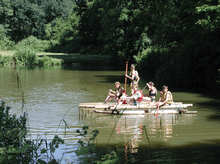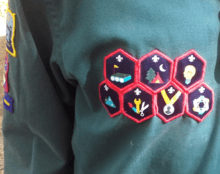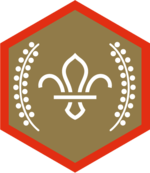Scouts (The Scout Association)
The Scout section is the direct descendant of the original Scout Patrols which formed The Scout Association of the United Kingdom in 1908. The section is open to both boys and girls between the ages of 10½-14 years, and are now formed into local Scout Troops which in turn form part of a Scout Group. The Scout section follows on from the Cub Pack (8-10½ year olds) and Scouts will move onto the Explorer Scout section at the age of 14.
| Scouts | |||
|---|---|---|---|
| Owner | The Scout Association | ||
| Age range | 10½-14 | ||
| Headquarters | Gilwell Park, London | ||
| Country | United Kingdom | ||
| Founded | First event 1907; Formalised 1908. | ||
| Membership | 124,714 young people (2014)[1] | ||
| Affiliation | Sea Scouts Air Scouts | ||
| |||
A general Scouting programme is adopted by Scout Troops, but it is possible for specialist troops to be formed. Sea Scouts and Air Scouts are examples of specialist programme troops.
History
The Boy Scout section was the first element of Scouting devised by Robert Baden-Powell, which he tested at an experimental camp on Brownsea Island in Dorset in 1907 and which was launched with the publication of Scouting for Boys in 1908. Initially, boys formed themselves into Boy Scout Patrols and then sought adult leadership, resulting in the formation of local Boy Scout Troops, each of several Patrols.[2] Contained in the pages of Scouting for Boys was Baden-Powell's Scout training scheme, a series of tests intended to build character and good citizenship in boys aged 11 to 18 years. These tests were revised several times and underwent thorough reviews in 1944, 1946 and again in 1958 without altering the basic structure of the scheme.[3]
In 1942, a "Post-War Commission" established by Lord Somers, the Chief Scout, recommended separate provision for over 15 year-old Scouts, as it had been found to be difficult to keep older boys in the Scout Troop. The details of the new Senior Scout scheme were published in May 1943 and it officially commenced in October 1946;[4] Scouts over the age of 15 could stay in the Troop, join a Senior Scout Patrol within the Troop, or join a separate Senior Scout Troop which was to consist of at least two Senior Patrols.[5]
A further and more radical review called the Chief Scouts' Advance Party was formed in 1964 and published its findings in 1966. Its recommendations for the Boy Scout section included a change of title to "Scout section", a revised Scout Law and Promise, a new uniform, replacing shorts with long trousers and a new three staged Progressive Training Scheme, intended to allow new entrants to advance more quickly. The age range was also amended to 11 to 16 years, due to the creation of the Venture Scout section which replaced Senior Scouts and Rover Scouts.[6] These changes were implemented in October 1967.[7]
The training scheme was again revised in 1984,[8] and in 1990 the decision was taken for all sections to become co-educational allowing the first girls to join Scout Troops.[9] In 2000, the report of The Programme Review recommended a new uniform which was introduced in 2001 and a revised training programme featuring Challenge Badges which was launched in 2002. This included a change in the age range to 10½ to 14 years because of the creation of the Explorer Scout Section.[10] The Challenge Badges themselves were revised in 2015, with a greater focus on outdoor activities.[11]
Organisation

The Scout Troop forms the senior section of Scout Groups. Since the programme review in 2003, this section is open to 10½-14 year olds. Most Groups will have one Troop, while some others may be able to support two or even more, depending on the numbers of Scouts within the Group. This is quite rare, as new Groups would be created in areas of large Scouting populations. Scout Troops have an adult leadership team consisting of an appointed Scout Leader and one or two assistant leaders. They can also be supported by adult helpers or Young Leaders.
The Scouts within the Troop are separated into Patrols, ideally of 6-8 members, with a Patrol Leader and an Assistant Patrol Leader. These positions are usually filled by Scouts who have shown an ability to be responsible and pro-active. they are normally around the age of 14 years of age but many Scout troops do vary which is very interesting in some aspects of modern Scouting life. Some Troops may also hold a position for a Senior Patrol Leader.
Within the Troop, the Patrol Leaders can hold a council and are able to plan and run activities under the supervision of the Scout Leader.
The Scout District may also hold a council for representative Patrol Leaders from each Troop to attend.
Awards

Scout Membership Award
The Membership Award is only actually received by young people new to Scouting, whereas those Scouts who have joined from a Cub Scout Pack will undertake the Moving-On Award. However, the Awards cover the same basic principles, and many Troops will have all new Scouts participate in the Membership Award, regardless of how they came to join the Section.

Challenge awards
There are ten Challenge awards, covering the six Programme Zones or key areas of the Scout programme. The Zones are: Outdoor and Adventure, Beliefs and Attitudes, Community, Fitness, Creative and Global.[12] Each Challenge involves undertaking several tasks or taking part in activities related to a particular Programme Zone.[13] Upon completing eight of the Challenge awards, some of which are compulsory, a Scout will have earned the Chief Scout's Gold Award.[14]
Activity badges
Activity badges are awarded for demonstrating skill or achievement in a particular subject which may be an existing hobby or a new area of knowledge.[13] There are currently 73 different badges available.[15] Six other activity badges have different levels or "stages" to recognize levels of achievement on subjects like swimming, music and information technology; these Staged Activity Badges can be gained and worn in all four of the training sections, from Beavers through to Explorers.[16]
Uniform
History
In Scouting for Boys, Baden-Powell recommended a distinctive and practical uniform that was "very like the uniform worn by my men when I commanded the South African Constabulary".[17] This in turn, seems to have been derived from the dress adopted by Baden-Powell in the Second Matabele War of 1896, influenced by his friend and colleague, Frederick Russell Burnham.[18] The original Boy Scout uniform consisted of a khaki shirt and shorts, a neckerchief or "scarf", campaign hat (known as a "B-P hat" in Britain) and a Scout staff. The exact specifications for these items were formalised in 1910.[19] The first Sea Scout uniform was a seaman's cap issued at an experimental camp in Hampshire in August 1909; a navy blue jersey was adopted soon afterwards.[20] The Boy Scout uniform remained largely unchanged for the first 60 years, although the woggle began to replace the knot used to fasten the neckerchief from the early 1920s,[19] and in 1954, a beret was introduced as an alternative to the expensive and awkward hat, green for Boy Scouts and blue-grey for Air Scouts.[21]
In 1966, the Advance Party Report recommended a total redesign and modernisation of the uniform, because of "the Boer War appearance of our uniforms" and commenting that the "wearing of shorts by members of the Movement is one of the most damaging aspects of our present public image".[22] The Scout section were to wear a long-sleeved dark green shirt and long trousers in a brownish colour described as "mushroom".[23] These recommendations were accepted and implemented from October 1967.[24] Later amendments included the abolition of all uniform headgear except Sea Scout caps and Air Scout berets in 1989. In 2001, following a consultation process within the association, a new range of uniforms designed by Meg Andrews was launched on Founder's Day, 22 February.[25]
Current uniform
The present Scout uniform consists of a long-sleeved shirt of a blue-green colour, described as "teal", a neckerchief and woggle, and navy blue combat trousers, known officially as "activity trousers". A skirt, activity shorts, a polo shirt and a grey fleece jacket are available as options. Sea Scout uniform differs by either a navy blue jersey or a light blue shirt; headgear is a seaman's cap with a "Sea Scout" tally band. Air Scouts wear a light blue shirt and headgear is a blue-grey beret. Adult leaders wear a shirt of a light khaki colour, described as "stone"; Sea Scout and Air Scout leaders wear a light blue shirt, with either a white-topped officer's peaked cap or a blue-grey beret respectively.[26]
Events and activities
Other activities
The Scout Programme includes many other activities — too many to fully list. The most common activities are:
All Scouting activities are properly supervised by qualified instructors for that activity.
See also
- Boy Scout
- Age groups in Scouting and Guiding
References
- "The Scout Association's Annual Report and Accounts 2013-2014" (PDF). The Scout Association. Retrieved 9 October 2014. (pp. 51-52)
- Moynihan, Paul (2006), An Official History of Scouting, Hamlyn, ISBN 978-0-600-61398-5 (pp. 30 and 39)
- Moynihan pp.176 and 180
- Moynihan pp.176-177
- Balsillie, Melville (1964), Running a Senior Scout Troop, The Boy Scouts Association (p. 11)
- Gordon, Alan and Brooks, Peter (editors) 1982, 75 years of Scouting: A history of the Scout Movement in words and pictures, The Scout Association, ISSN 0263-5410 (p. 42)
- Moynihan pp.180-181
- Moynihan p.183
- Moynihan p.184
- Moynihan p.185
- "News - More fun. More choice. More adventure". The Scout Association. Retrieved 2 April 2016.
- "Member Resources - Scouts - Balanced Programme". www.scouts.org.uk. The Scout Association. Retrieved 26 October 2013.
- "Member Resources - Scouts - Scout badges and awards". www.scouts.org.uk. The Scout Association. Retrieved 26 October 2013.
- "Chief Scout's Gold Award". www.scouts.org.uk. The Scout Association. Retrieved 26 October 2013.
- "Member resources - Scouts - Badges and awards - Activity badges". www.scouts.org.uk. The Scout Association. Retrieved 26 October 2013.
- "> Member resources - Cubs - Badges and awards - Staged activity badges". www.scouts.org.uk. The Scout Association. Retrieved 26 October 2013.
- Baden-Powell, Robert (1908), Scouting for Boys (Campfire Yarn No 2), www.thedump.scoutscan.com Grumpy Ogre Productions. Retrieved 22 February 2015
- Jeal, Tim (1989) Baden-Powell,Hutchinson, ISBN 0-09-170670-X (p.188)
- Moynihan pp. 82-83
- Moynihan p. 47
- Moynihan p. 178
- The Boy Scouts' Association (1966), The Chief Scout's Advance Party Report (p. 77)
- Advanced Party Report 1966, pp. 155-158
- Moynihan p. 185
- Moynihan pp. 184-185
- "Chapter 10 - Uniform, Badges and Emblems" (PDF). Policy, Organisation and Rules. The Scout Association. Retrieved 4 April 2016.